Only Collect
A poet walks through the Metropolitan Museum's Vollard exhibit, and thinks of Rilke, dogs looking in mirrors, and his Vuillard neurosis.
Introduction
Ambroise Vollard, Patron of the Avant Garde
The Metropolitan Museum of Art
September 14, 2006–January 7, 2007
Rilke: Pious Student of Rodin and Cezanne
In the fall of 1907, the poet Rainer Maria Rilke was living in Paris and reading proofs for New Poems [1907], a book that turned hard from his earlier style and owed much to what he’d learned working as Auguste Rodin’s secretary a few years earlier. The first part of his Rodin monograph appeared in 1903; in 1907 he was finishing the second. During those four years he’d worked to develop an equivalent in poetry to things he watched Rodin make. He was turning from the more effusive utterances of his earlier poems toward a poetry fresh (to use the kind of language he favored) with its own thing-ness. The poems in his Book of Images (1905) were like lines in a perspectival plan radiating from the vanishing point of pure subjectivity, but now he wanted a poem to be a freestanding solid, like a chunk of marble or bronze one could walk around. By 1907 his experience with Rodin was being influenced by other art experiences fraught with consequence.
The Salon d’Automne of 1907, an exhibition held in the Grand Palais (built on the Champs-Élysées for the 1900 World’s Fair), gave over two rooms to pictures by Cézanne, who had died the year before. Rilke reported his Salon visits and the effect Cézanne’s work was having on him in almost daily letters to his wife, Clara. He also reported his responses to a portfolio of van Gogh reproductions that reminded him, as he had begun to learn from Rodin, that anything might be a subject for art. Rilke revered van Gogh’s physical poverty, in part because his work transformed it into forceful beauty. “He’s in a bad way, night and day,” Rilke says in a letter, recalling van Gogh’s deprivations. ”But in his paintings poverty has already become rich.” From Rodin he’d learned to look at objects long and hard: Rodin, who always had something in progress waiting to be attacked, admonished Rilke to go find motifs (gazelle, panther, ancient piece of sculpture, flamenco dancer) and simply work, not wait for inspiration. Not only did Rilke admire van Gogh’s and Cézanne’s pictures, but he also hoped to emulate the unity of life and art he saw in their working process. He clung to van Gogh’s remark that instead of the saints of classical art he would make his saints a crude bed, or lamp, or postman or prostitute, just as Cézanne—so pathologically shy that he could barely tolerate being among others—would make his own saints out of old fruit, bedspreads, compotes, and dusty wine bottles.
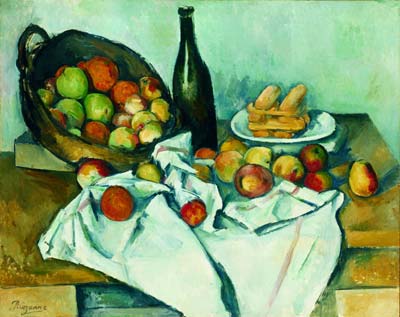 Paul Cézanne, The Basket of Apples. The Art Institute of Chicago, Helen Birch Bartlett Memorial Collection (1926.252). Photo: Photograph The Art Institute of Chicago Paul Cézanne, The Basket of Apples. The Art Institute of Chicago, Helen Birch Bartlett Memorial Collection (1926.252). Photo: Photograph The Art Institute of Chicago |
Rilke was a pious student of his exemplars, and he saw Cézanne’s art as a devotional practice: “Only a saint could be as united with his God as Cézanne was with his work.” While the work is the expression of the artist, the artist in a sense is also a product or expression of the work. Spiritual aspiration is never far from Rilke’s consciousness. Cézanne is a prophet-artist of biblical stature: “Not since Moses has anyone seen a mountain so greatly.” And when he insists that Cézanne possesses “scales of an infinitely responsive consciousness,” he’s restating what he learned from Rodin, that every centimeter of a surface, whether of a statue, a painting, or a poem (which is to say, a poem’s syntactical facets), expresses some degree of response to the occasioning event or motif. The most decisive remark Rilke made about Cézanne, I think, and about a certain kind of art, is that in treating his subjects, Cézanne left the love out. The painting of sentiments, Rilke says, “is in no way better than the painting of things; painters of sentiments paint I love this here; instead of painting: here it is.” Cézanne wanted his pictures looked at not for the value he attached to his subject but for the singular unrepeatable reality that each comprised. Of a self-portrait in the Salon d’Automne, Rilke says that it’s as if a dog were looking into a mirror thinking, “There’s another dog.” There was nature, there was the motif, and there was the second, superior nature of the object: “picture-nature.” In these years Rilke crafted a verbal equivalent of what he believed Cézanne’s setups became: “how thinglike and real they become, how simply indestructible in their stubborn thereness.”
Vollard: The Secretive Collector
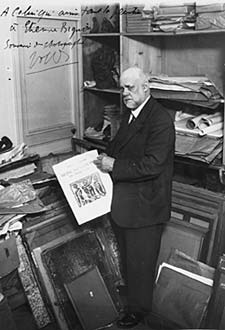 Thérèse Bonney, Vollard at 28, rue Martignac. Musée d'Orsay, Paris. Thérèse Bonney, Vollard at 28, rue Martignac. Musée d'Orsay, Paris. |
Vollard included 150 Cézannes in the 1895 show. He also sat for a portrait. (Several portraits that artists made of him appear in the exhibition.) He described in a reminiscence, with an exaggeration that came naturally to him, sitting for more than a hundred hours—the artist told him “to sit like an apple”—until Cézanne announced, with just the sort of biblical stubbornness Rilke admired, “I am not dissatisfied with the shirt front.” A large, dour, mildly narcoleptic man who would nod off even during arguments he enjoyed provoking, Vollard was notoriously secretive and evasive. He revealed little of himself; concealed handwritten sales records, stock books, and nearly indecipherable notebooks; and was so impulsively savvy that he sometimes carted away nearly all the studio contents of an artist who interested him. His showroom must have looked like a garage sale, with dozens of paintings turned to the wall or piled high on the floor or scattered about in open crates. He was distracted like a fox, though—insiders knew he kept a hoard of superior pictures in the back of his shop and wouldn’t allow buyers to see them until their value shot up.
Walking the Exhibition: Cezanne's Sweep, Van Gogh's Saints, and Degas!
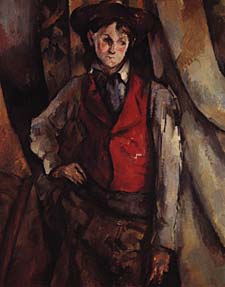 Paul Cézanne, Boy in a Red Waistcoat. National Gallery of Art, Washington, D.C. Collection of Mr. and Mrs. Paul Mellon, in Honor of the 50th Anniversary of the National Gallery of Art (1995.47.5). Photo: Image Board of Trustees, National Gallery of Art, Washington, D.C. Paul Cézanne, Boy in a Red Waistcoat. National Gallery of Art, Washington, D.C. Collection of Mr. and Mrs. Paul Mellon, in Honor of the 50th Anniversary of the National Gallery of Art (1995.47.5). Photo: Image Board of Trustees, National Gallery of Art, Washington, D.C. |
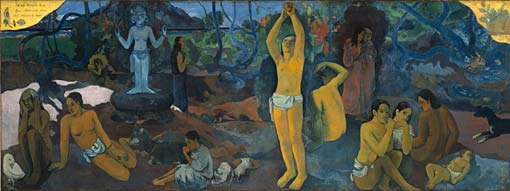 Paul Gauguin, Where Do We Come From? What Are We? Where Are We Going?. Museum of Fine Arts, Boston, Tompkins Collection––Arthur Gordon Tompkins Fund (36.270). Photo: Photograph 2006 Museum of Fine Arts, Boston Paul Gauguin, Where Do We Come From? What Are We? Where Are We Going?. Museum of Fine Arts, Boston, Tompkins Collection––Arthur Gordon Tompkins Fund (36.270). Photo: Photograph 2006 Museum of Fine Arts, Boston |
This kind of big-tent exhibition brings together pictures like Gauguin’s epic Where Do We Come From? What Are We? Where Are We Going? from Boston, Bonnard’s The Terrasse Family from Chicago, Cézanne’s Bathers from St. Louis and The Smoker from St. Petersburg, not to mention a couple dozen works from private collections. Suggestions fly everywhere you turn. The sleeves of Cézanne’s Boy in a Red Waistcoat are constructed of planes and shards of color, and the pant folds are slippery louvers of grays, blues, and greens. The more the conventional figure breaks down, the more the subject makes sense in its own painterly terms, because its sense lies in the action of inquiry the picture itself records, softened shingled brushstrokes laid beside and across each other as a modeling of the artist’s form-finding desire. Not only does this picture speak to other Cézannes, it’s also one of the workshops out of which would issue the Cubism we see in Picasso’s own portrait of a granite-quarried, heavy-lidded Vollard. There are also suggestive moments when we recognize that while poets can’t use painting’s expressive means, there are yet instructive parallels. To see Cézanne swiftly articulating knuckles in The Card Players with one tightly oscillating brushstroke reminds a poet that the tighter the economy of syntax, the speedier its continuity.
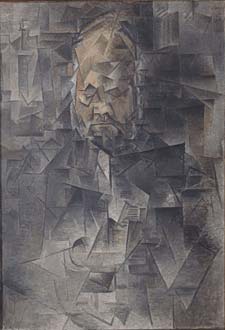 Pablo Picasso, Ambroise Vollard. Pushkin State Museum of Fine Arts, Moscow. Photo: Pushkin State Museum of Fine Arts, Moscow 2006 Estate of Pablo Picasso/Artists Rights Society (ARS), New York Pablo Picasso, Ambroise Vollard. Pushkin State Museum of Fine Arts, Moscow. Photo: Pushkin State Museum of Fine Arts, Moscow 2006 Estate of Pablo Picasso/Artists Rights Society (ARS), New York |
Vollard began showing Vuillard, Bonnard, and others who called themselves Nabis (Hebrew for “prophets”) in the late 1890s. I confess to a Vuillard neurosis. I love the flatly knitted surfaces of his domestic interiors, but their ambience is so airless and shut down by the censures of social and familial conventions, so compacted into self-satisfied edge-to-edge stuffiness, that I feel the casket lid closing over my head. How different was his friend Bonnard’s feeling for middle-class pastimes. A plumped bonhomie spreads throughout Bonnard’s outdoor family picture, The Terrasse Family (Afternoon of a Bourgeois Family), held together by a tub of a woman in the center who seems to be inflating as we watch. Bonnard’s colors have a lightning lightness—loose, ventilated, on the fly. He puts his outdoor scene, filled with slightly solemn adults and children, just this side of the sinned-in Garden. Bonnard could be a darker, more direly reflective painter, especially when the subject was sex, but in this enchanted picture, expansive sensation is all.
 Pierre Bonnard, Ambroise Vollard with His Cat. Petit Palais, Musée des Beaux-Arts de la Ville de Paris. Photo: Petit Palais Photothèque des Musées de la Ville de Paris / Pierrain, 2006 Artists Rights Society (ARS), New York / ADAGP, Paris Pierre Bonnard, Ambroise Vollard with His Cat. Petit Palais, Musée des Beaux-Arts de la Ville de Paris. Photo: Petit Palais Photothèque des Musées de la Ville de Paris / Pierrain, 2006 Artists Rights Society (ARS), New York / ADAGP, Paris |
The installation shows how the painterly imagination works. One wall displays several canvases by a 19-year-old Picasso. His figures were already bold and impudent, as was his painterly attack. Even then he was an unstoppable menace, colonizing subjects, forms, and materials to feed his voracious expressive appetites. His females look straight at each other, at themselves in mirrors, or out at us (the anxious peepers). In one small picture, a nude girl with cats sits on a bed, the feline shapes coiled into an unreleased spring of sexual potential. It’s carnal compulsion all wrapped up in the flash of the making of the thing, and it looks ahead to the feral energy of his later nudes. I can’t think of any instance when Rilke came anywhere near the boldness of regard for the nude that Picasso was already achieving in 1901, but the formal construction of his great poem “The Spanish Dancer” (from New Poems) has a similar circular energy. Like Picasso’s little picture, it wraps itself around itself as the dancer, whom Rilke compares to a struck match, masters the metaphor she has become and, after flaring and burning, finally stamps out the little conflagration of her dance beneath her feet.
 Edgar Degas, Dancers at the Barre. The Phillips Collection, Washington, D.C., acquired 1944. Edgar Degas, Dancers at the Barre. The Phillips Collection, Washington, D.C., acquired 1944. |
Cézanne to Picasso: Ambroise Vollard, Patron of the Avant-Garde is on view at the Metropolitan Museum of Art in New York City until January 7, 2007.
W.S. Di Piero was born in 1945 in Philadelphia, Pennsylvania and earned his BA from St. Joseph’s College and MA from San Francisco State College. A poet, essayist, art critic, and translator, Di Piero has taught at institutions such as Northwestern University, Louisiana State University, and Stanford, where he is professor emeritus of English and on faculty in the prestigious Stegner Poetry Workshop...


